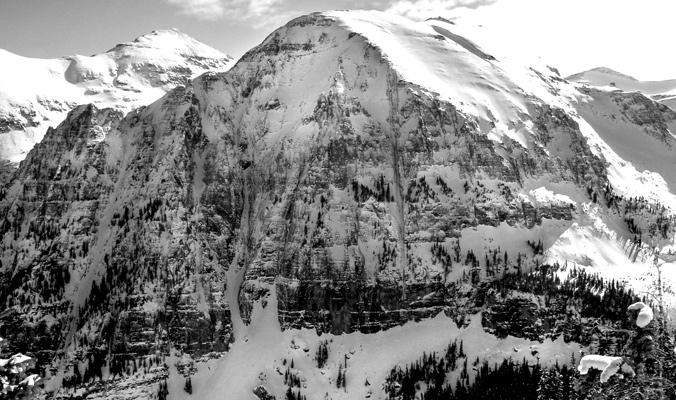
The iconic Little Wasatch Face, visible form telluride Ski Resort, cuts a striking profile with its dual couloirs dubbed Heaven’s 11—the 11s for short. Andy Sawyer claimed the first descent of the 11s in 1994 and, later that afternoon, Peter Inglis followed suit. [Photo] Brett Schreckengost
Southeast of Telluride Ski Resort’s boundary, a pair of expansive cirques form the upper headwaters of Bear Creek and its east fork. The bowls are packed with couloirs—the San Joaquin being the most notable—and other lines that fall away from the resort’s many gates. From the creek branches’ confluence, which lies between Wasatch Mountain and the resort’s Gold Hill, Bear Creek flows north through a tightly constricted valley along the Wasatch Trail and into the town of Telluride. It’s a relatively quick and straightforward exit for any sidecountry skier. But the battle over access to the Bear Creek drainage has been neither quick nor straightforward, with a half-dozen openings and closures since the 1980s.
Preceding the late ’90s, when ski area boundaries were commonly locked down more tightly than Hermann Maier’s Langes, access into Bear Creek remained prohibited for more than a decade. Poaching happened, but consequences were serious—in 1998, for example, skiers Himay Palmer and Matt Lewis were arrested after exiting the Forest Service land, which they’d traveled through from the nearby town of Ophir.
The Telluride Mountain Club, under the leadership of current and past presidents Peter Inglis, Steve Johnson and Andy Sawyer, lobbied hard for access, bringing together stakeholders, including the resort and the San Miguel County sheriffs office, and researching past accidents, boundary violations and the growth of avalanche education. Their efforts saw rewards in 2000, when patrol installed and opened gates for Bear Creek and Gold Hill, which today encompasses 10 inbounds, hike-to chutes. More gates were added over the subsequent decade until 2010, when Bear Creek’s story really gets complicated.
That’s when Tom Chapman, a real-estate developer known for buying private mining inholdings within public lands and proposing controversial developments, came to town. Chapman, whom the Wall Street Journal has called The Buzzard of the Backcountry, purchased 103 acres of mining land that formed a swath across the Wasatch Trail near the junction of Bear Creek’s forks. In December 2010, Chapman told Wildsnow.com that he planned to reopen the mines, build a 1,000-square-foot home, create some sort of ecotourism-focused lodging (involving igloos, yurts and balloons) and fence off the land, prohibiting public travel. In response, the Forest Service closed Telluride’s eastern gates to prevent trespassing. Outcry was loud and widespread. Poaching followed. Lawsuits did, too.
“In a kind of selfish way, it was nice because it kept the yahoos out,” lifelong Telluride skier Greg Hope told me in 2015. “People still skied into Bear Creek. The patrol didn’t care, except for maybe one patroller, unless they were bombing the ridge.”
As a result of that poaching, the Forest Service opened the upper Palmyra gate in spring 2011, allowing access to upper Bear Creek. The ensuing years brought further poaching and evolving plans from Chapman, including for a ski area based on Silverton Mountain Resort’s no-trails model. By spring 2014, the controversy was settled in actual court and that of public opinion.
“Taking the access points away didn’t achieve the objectives we had hoped,” U.S. Forest Service Norwood district ranger Judy Schutza wrote in a letter to San Miguel County leaders that March, reinstating lower Bear Creek access. “It seems better to have a few access points than skiers ducking the ropes wherever and whenever.”
That May, the San Miguel County District Court affirmed the Forest Service’s decision, denying Chapman’s Gold Hill Development Company vehicular access to its land via resort property and the ability to prohibit public access across its mining claim. The following December, the Colorado Supreme Court rejected Gold Hill’s appeal to dismiss the prior ruling.
Since then, Chapman’s name appears now and again in the Telluride Daily Planet, including for a 2016 effort to build a $2-million single-family home on his Modena mining claim. But hemmed in by public land and court rulings, Chapman has since sold his Bear Creek mining claims.
“Tom Chapman has had a lot of plans, and he’s talked about a lot of things and it’s never gotten past stage one of talking,” former Telluride Mountain Club president Tor Anderson told the Telluride Daily Planet in 2014. “Just like any other landowner, he’s going to be bound by the county’s high country zoning rules.” And, ultimately, by the efforts of a vocal skiing population that cares deeply about its sidecountry access.
In writing about Telluride’s sidecountry history for the January 2016 issue of Backcountry, editor in chief Tyler Cohen skied the San Joaquin Couloir in rock-hard conditions and the Little Wasatch Face’s Grandfather Couloir, and he swears he came nowhere near to soiling himself out of fear.










Related posts:
Betsy Armstrong reflects on deep research and deeper turns